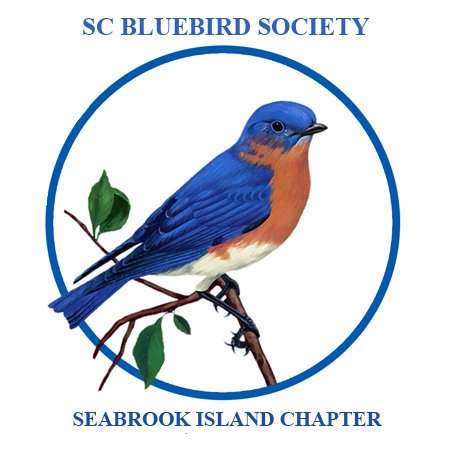
Most of your drives around our island in the summer will turn up a few Eastern Bluebirds sitting on a fence post or perched atop a nest box. They call out in a short, wavering voice and abruptly drop to the ground after an insect. Marvelous birds to capture in your binoculars or camera lens, male Eastern Bluebirds are a brilliant royal blue on the back and head, and warm red-brown on the breast. Blue tinges in the wings and tail give the grayer females an elegant look.

Many Seabrook Islanders and guests have noticed nest boxes around the island and especially on the golf course. There are boxes on the front and back nine of the Crooked Oaks course and the front nine of Ocean Winds. The other boxes are around the Lake House. In total there are 74 bluebird boxes on 4 Bluebird Trails around the island. The Seabrook Island Birders Bluebird Society is a sub group of the Seabrook Island Birders. Since 2014 this group has monitored all the boxes once a week from early spring until late summer once nesting begins and until the last baby bird has fledged. Statistics are kept on everything that happens in the bird box. Noted is the species of bird nesting, number of eggs, number of nestlings, and number of birds that fledge. Also noted if there was any evidence of predation from ants, wasps, snakes or raccoons, that may have invaded the nest box.
The Seabrook Island Golf Club and staff have been great partners in this endeavor. Not only do they allow the boxes to be on the courses and let the teams borrow golf carts to travel to the boxes that line the fairways, but they have paid for and installed baffles for all the boxes on the golf course. This dramatically reduced the number of snake predations.
So, armed with a bucket of supplies, a map of bird box locations, and a binder with statistics sheets for each box the team goes to every bird box in their area hoping to find activity. This sounds like a mundane task, and it’s not crocodile hunting, but it does have its challenges. You quickly learn to wear boots because many of the houses are near ponds or in high weeds. Once an Eastern Bluebird or Carolina Chickadee flies out of the house and straight for your head there is no chance that you will ever again approach the box any way but from the back or side. And, it is always wise to open the box with a gloved hand in the event there is a snake, a mouse, or insects in the box. Additionally, a long stick or golf club is nice to have to flush snakes or alligators or shoo away Wild Turkeys. With that no harm has come to wildlife or box monitors in our 10 years of data collection.
The monitor teams that go out in early spring have a couple weeks of checking empty boxes, but once the first nest is found activity ramps up. It’s a huge deal for the entire group when the first eggs are found or the first hatchlings get counted. And, once the hatchlings become fluffy with feathers, you know they are ready to fledge and will probably not be there the next week. As a monitor you are only responsible for 8 weeks and, even though this task is time spent out of your week, it is tough to turn in your bucket and binder to relinquish your babies over to another team.
All the data from the sheets are compiled into a report that are shared with the Seabrook Island Birders, the Seabrook Island Golf Club, the Seabrook Island Environmental Committee, and the South Carolina Bluebird Society.
If you are interested in seeing our statistics for this year, interested in the Seabrook Island Bluebird Society please fill out the form below.
